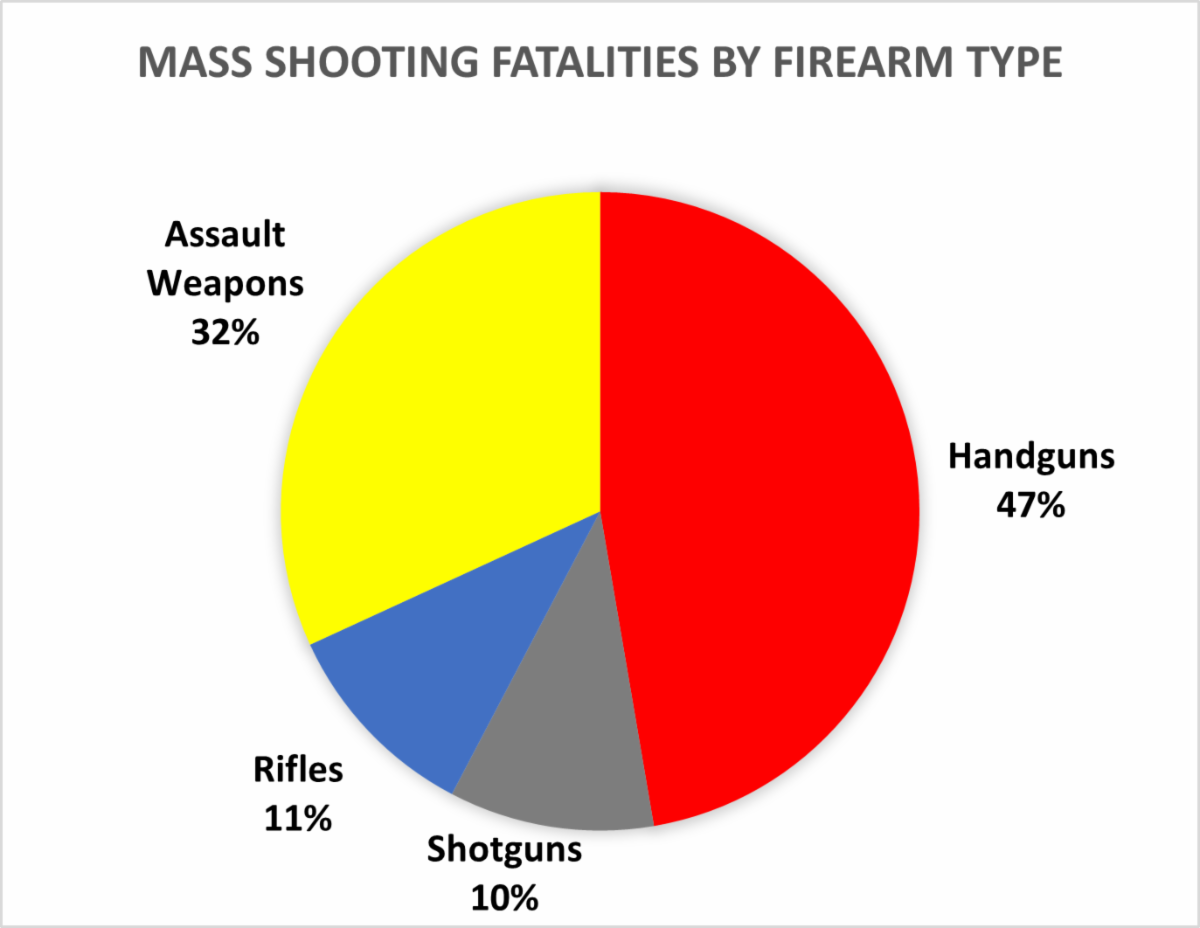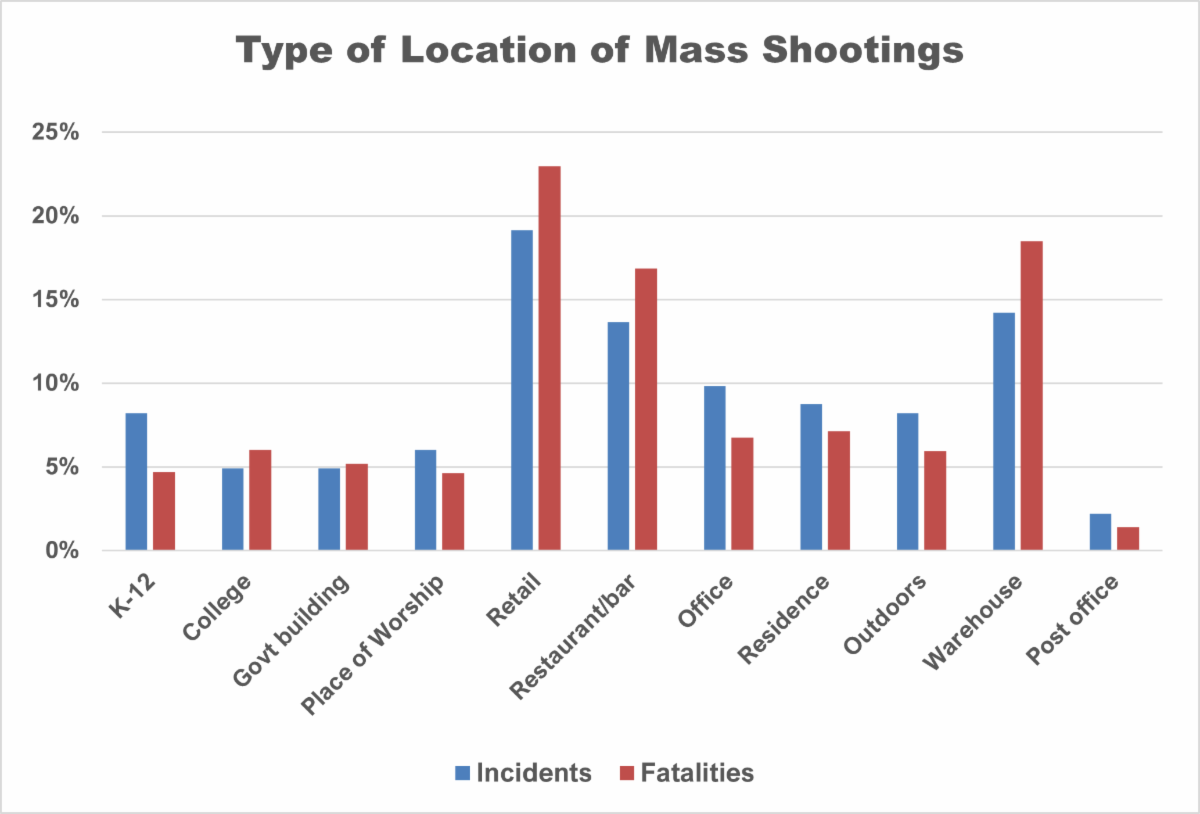In 2017, two researchers, Jillian Peterson and James Densley, decided to conduct in-depth research on every mass shooting that had taken place in America. Their research ultimately led to the founding of the Violence Project Center and a book in 2021 by the same name, which summarizes their research.
What I found particularly interesting and helpful, is that they compiled a large spreadsheet which summarizes their research and have made it available to the public. It contains information on about 150 parameters of every mass shooting in America, beginning with the Whitman shooting at the University of Texas in 1966. The latest entry when I downloaded was the Buffalo grocery store shooting in May1. It is an extremely valuable data resource on these horrific events.
One word of caution about the data on mass shootings. While these events may seem to us to occur frequently, they are quite rare, statistically speaking. As a result, one event with outlier characteristics can have a large effect on measures like medians and means, for example, which can lead to dubious conclusions.
Peterson and Densley defined a mass shooting for their database as an event where three or more people were killed by a firearm(s), not including the perpetrator. This is a slightly more expansive definition than the more common definition of four or more victims.
Using that definition, they documented 180 mass shootings in our country since 1966, that have claimed 1,267 victims and represent over 41,000 years of life lost.2
While those numbers are clearly horrific, mass shootings make up a tiny portion of the total homicides in the U.S. According to FBI stats, about one million Americans have died in a homicide since 1966, which means that mass shootings have accounted for less than .1% of all homicide victims. Some articles like this one by the Associated Press have begun discuss that public and political attention on mass shooting have obscured the damage being done by the shooting only involving a small number of victims.
Nonetheless, mass shootings seem somehow more tragic to us than other homicides. I suspect some of that has to do with the randomness and inexplicability of the events, which frightens us. In addition, they are such a breach of the underlying social contract on which our lives are based, they tear at the basic fabric of society. Also, the fact that many mass shootings have taken place at schools, claiming the most innocent among us, accentuates these tragedies.
Also alarming is that the frequency and death toll from mass shootings have been steadily increasing. Seven of the ten deadliest shootings happened in the last ten years. Since 1966 the five-year rolling annual average has increased from just one per year to over six. That is about 8 times faster than the US population has grown. The five-year average for the number of victims has increased from under ten to over 60. As such, mass shootings are clearly increasing at a much faster rate than homicides generally.

The Violence Project database has numerous data elements regarding the characteristics of each of the shooting incidents. There are three that I thought we should look at first to provide some context.
Sex, Age & Ethnicity of Perpetrators-
As you undoubtedly know, almost all mass shooters are men. Of the 182 mass shooting perpetrators, only 4 were women and they account for only 29 of the 1,267 victims.
The average age of mass shooting perpetrators is 33. However, the bulk of perpetrators are clustered in their 20s and then again in their mid to late forties. Of the 182 perpetrators, 24 (13%) were under 21 and they are responsible for 140 (11%) of the fatalities. The youngest mass shooter was 11 and the oldest was 70. In the deadliest mass shooting (Las Vegas, 2017), the perpetrator was 58.

Mass shooters are ethnically diverse. These are the categories that the Violence Project used.

Type of Weapon Used -
The Violence Project categorized the firearms used in the mass shootings as handguns, shotguns, rifles and assault weapons. Their differentiation of rifles from assault weapons is based on the definition used in the Assault Weapons Ban of 1994, which includes a semi-automatic rifle with certain features, such a detachable clip. Their research indicates that 300 firearms have been used in the mass shootings.
They were only able to determine that about 50 of weapons used were either purchased illegally or the perpetrator was illegally in possession of the firearm(s). So, while their research is somewhat incomplete on this point, it appears that a substantial majority of the guns used were legally purchased and possessed by the perpetrator at the time of the shooting.
The majority of the shootings were carried out with handguns. Assault weapons came in second at 22%, with other rifles and shotguns each at just over 10%.

However, assault weapons account for a disproportionately higher percentage of the fatalities in mass shootings. This percentage would have been even higher if the recent shootings had been included in the database.

Assault weapons were used in eight of the ten shootings with the highest fatalities and their popularity with mass shooters has been increasing over time.
Types of Locations -
Because of the horrific nature of shootings at schools and places worship, they dominate our consciousness and the media’s coverage. However, school shootings make up less than 10% of the mass shooting incidents and fatalities. Those at places of worship and colleges are about 6% each.
Shootings at retail locations, restaurants and bars make the largest portion, accounting for a third of all incidents and fatalities. At just over 20%, employment settings are the second most common location where mass shootings occur.

As I suspect you are beginning to see, there is a maddening variability in mass shootings. There are far fewer common elements than I was expecting. This variability makes these events difficult to understand and, as a result, harder to fashion policies that would reduce their incidence. Next time, I will look at some of the common characteristics of the shooters themselves, which I think will help begin to bring into focus something about the type of individual that commits these heinous acts.

